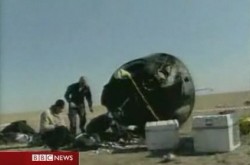This is taken directly from Universe Today, article by Ian O'Neill (www.universetoday.com)
Soyuz Capsule Hatch Nearly Burned Up and Crew's Lives Were on a "Razor's Edge"
Written by Ian O'Neill

First, Russian space officials tried to cover up the emergency landing of the Soyuz descent capsule on Saturday. Then they blamed the crew for changing their flight plan without communicating with mission control. Compounding the problem, an official cited a bad omen as a contributing factor to the hard landing. Within a couple of days, the truth behind the Soyuz "ballistic re-entry" began to come to light. Today, even more shocking revelations are being reported, including how the escape hatch nearly failed during the uncontrolled, fiery re-entry…
On Sunday, the Universe Today reported on the off-target landing of the Russian Soyuz descent capsule carrying South Korea's first astronaut, Yi So-yeon, Russian cosmonaut Yuri Malenchenko and NASA record breaker (for most time spent in space) American Peggy Whitson back from the International Space Station (ISS). The capsule had landed short of its intended target, 20 minutes behind schedule. The authorities later blamed the mishap on a change in flight plan and suggested the crew were to blame. Then, surprisingly, Federal Space Agency chief Anatoly Perminov placed some of the blame on the female dominant crew, saying women on board space missions were bad luck.
Yesterday, I reported on some updates to the drama that had unfolded. Apparently, even before the rescue helicopters had located the capsule, the Russian space agency publicised the crew's safe return, covering up the fact they had no idea where they were. What's more, the helicopters had been sent to the wrong location, and it was by chance that the capsule's parachutes were spotted. The capsule had landed in a zone reserved for emergency touch-downs and the crew suffered a "hard landing". Not being able to send a signal to mission control, the crew remained upside down, strapped to their seats for 25 minutes. Malenchenko was able to unlatch himself to get outside to use a satellite phone. Some news agencies reported that the parachute had even caught alight and set the surrounding vegetation on fire.
Today, even more revelations have been reported. According to an unnamed Russian space official, the capsule had entered the atmosphere in an uncontrolled manner. Rather than the capsule's heat shield taking the frictional re-entry burn, the escape hatch became exposed and bore the brunt of the high temperatures outside. The hatch sustained substantial damage. The antenna was also exposed to the heat, completely burning it up, explaining why the crew were unable to communicate with the ground. A valve that equalizes cabin with atmospheric pressure was also damaged.
"The fact that the entire crew ended up whole and undamaged is a great success. Everything could have turned out much worse. You could say the situation was on a razor's edge." - Anonymous Russian space official involved in the descent investigation.
Russian Federal Space Agency spokesman, Alexander Vorobyov, continued to downplay the series of events saying that antennae were regularly damaged during capsule re-entries. He rated Saturday's event as a "3", where "5" on the scale would be critical.
This troubled landing has naturally raised questions about the safety record of the Soyuz capsules currently being used. This is the second time in a row (and the third since 2003) that there have been serious problems during re-entry of Soyuz capsules. The official continued to say that there can be no guarantee that this will not happen again:
"Considering that this situation has repeated itself, it is obvious that the technological discipline in preparing space equipment for a flight is declining. There is no guarantee that the crew of a Soyuz spacecraft landing a half a year from now would not face the same difficulties." - Anonymous Russian space official
During the confusion as to where the Soyuz capsule had landed, there are unconfirmed reports that the U.S. Defence Department tracked the off-target landing and pinpointed its location for Russian helicopters. NASA is reserving comment until the Russian Federal Space Agency finds the cause of the uncontrolled descent.
Investigators suspect that the ballistic re-entry was caused by an electrical short in the cable that connects the crew capsule's control panel with the Soyuz descent hardware. A short circuit in this cable can automatically trigger the ballistic re-entry mode and there is little the crew could have done to prevent it.
Sources: The Associated Press, New Scientist
No comments:
Post a Comment